Fresh basil growing in the garden is one of our favorite sights of summer. We intentionally try to over-plant basil each year as it’s so versatile in the kitchen, in soups, salads, sandwiches, or pizzas.
This year we grew two varieties of basil, ‘Aroma 2’, and the large-leaf basil ‘Nufar Genovese’. Of the two, my personal favorite is ‘Nufar Genovese’. The plants are very productive, and their larger leaves go further when making pesto, and are easier to roll up and chiffonade. Unlike some herbs that lend themselves well to drying, like thyme and rosemary, basil is always best when freshly picked from the garden. If you have more basil than you can use fresh though, don’t let it go to seed, make pesto!
3/4 Cup Extra Virgin Olive Oil
2 Garlic cloves
2 Tbsp Pine nuts or Walnut pieces
1/4 Tsp salt
1/3 Cup coarsely grated Parmigiano Reggiano*
4 cups packed, fresh, Genovese basil leaves
*As cheese texture may be altered by freezing, we prefer to omit the cheese, and add it to the pesto after thawing.
Remove the leaves from the stems, discarding any flower buds, and rinse thoroughly in cold water. If your home-grown basil has signs of aphids, small snails, or similar pests, fill the sink with cold water, add 1 Tbsp salt, and soak the leaves for 10 minutes. The unwelcome guests will fall to the bottom of the sink.
Drain, and rinse the basil leaves thoroughly in cold water.
Place all of the ingredients, except the basil, into a blender or food processor. Blend until smooth. Add the basil one handful at a time, blending until all the basil is incorporated, and the pesto is of an even texture.
Buying ready-made pesto can be expensive, and in my opinion, is rarely satisfying. I often find commercially prepared pestos to be excessively oily, or salty, and lacking in any real freshness of flavor. Homemade pesto though is simple, can be adjusted to taste, and freezes easily, helping to extend one of the freshest flavors of summer, deep into fall and winter.
If storing pesto for later use, I recommend freezing it in various sized portions. Freeze some individual servings in ice cube trays or small muffin tins, and once frozen, empty the trays and place the frozen pesto cubes in freezer bags. These small quantities of pesto are perfect for swirling into winter soups, or using in sandwiches. Larger portions may be frozen in small reusable 1/2-1 cup storage containers, handy for serving over pasta, or pizza. Don’t forget to add the cheese to the thawed pesto if it was omitted at the time of freezing.
Grocery store basil is often exorbitantly priced. If you’re not growing your own, or don’t have enough, local Farmer’s Markets here have recently been selling lush large bunches of basil for just $1 each during peak season. There’s no excuse, now is the perfect time to pesto!

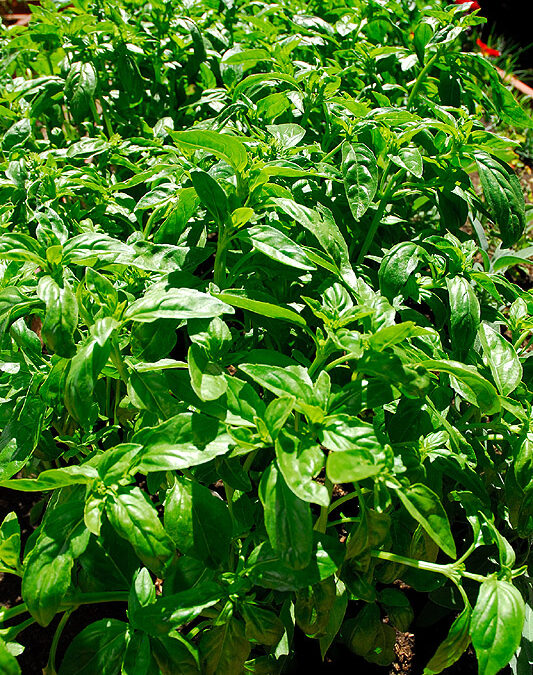


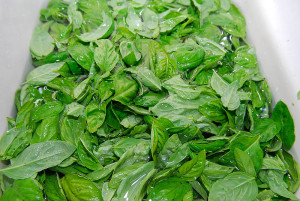
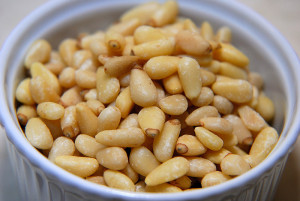

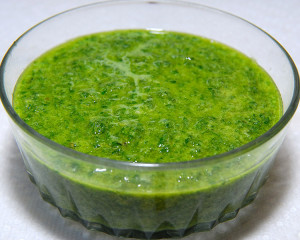
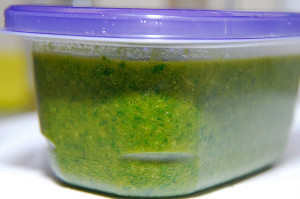







Thanks for the reminder I need to pick my basil and make more pesto. I made it about a month ago; that is gone so it is time to bring out the Cuisinart! I think I will try it with walnuts time.
Mmmm. Pesto is Mr. Mouse’s favorite food (right after chocolate). I’ll have to try this recipe. Thanks!
I grow basil specifically for making pesto. I’ll have to try your recipe sometime. It’s great with pasta and chicken!
Dear Clare, Any dish which includes the addition of, or is made from, fresh basil has my vote. Oh to be able to grow it in quantity rather than relying on a pot.
It is strange to reflect that in my childhood in Britain in the 1950s fresh basil, as a kitchen essential, was, as far as I am aware, completely unheard of.
Edith, I honestly don’t remember fresh basil in England, even in the 1970’s. I think I always assumed basil came dried, chopped, in small glass jars from Sainsburys! Now I don’t know how I spent the first half of my life without it! 😛
Get me to the farmers market!!! I always forget to do this, thanks for the reminder Clare.
I LOVE pesto. I have a great recipe for it, but yours looks just as delicious! What I like to do is coat some chicken breasts, and bake the chicken. Near the end of the baking I put a tomato slice and some more parmesan on the top of that to melt and bake it some more. Super, super awesome 😀
Mmmm, that sounds tasty Kyna! I bet the chicken would be good with melted fresh mozzarella in place of the parmesan too! 😀 Any recipe that uses tomatoes AND basil this time of year, is a good thing!
That does look delicious! How wonderful to have such bounty in your garden!
I’m sure the aroma from those freshly picked leaves was lovely in the kitchen. I’ve never made homemade pesto before and never got around to sowing the seeds that are in my garage so maybe next year with some walnuts.
Rosie, I think once you’ve had homemade, you’ll never go back. I’ll remind you to plant your seeds in spring 😉
Can never get enough of fresh basil or this yummy pesto recipe. Happy September, dear Clare 🙂
I agree, no such thing as too much basil. I can’t believe it’s September. How? How? Wasn’t it just spring !?!
Thanks for this! I was just looking at a bolting row of basil this morning, and freezing pesto had not occurred to me. I’m sick of fresh pesto right now, but by December I’d have been wishing I’d saved some! I’ll do it now.
Yum, Yum! I freeze pesto in reused yeast jars. They are nice and small. Also I use cashews instead of pine nuts. But sadly my basil never grew much at all this year. Not sure if it was due to the lack of heat or maybe not enough water. I’m guess lack of heat because other plants around the basil grew well and received the same amount of water. There’s always next year!
That’s interesting Jackie. Our Basil this year actually did well, despite the cool summer weather we’ve both had this summer. Our tomatoes have been slow, like yours, and our peppers…well, let’s just say we’re really disappointed in the peppers so far…but the basil, thankfully still put on a show.
Must make this and soon!
Absolutely deliciious sounding. What, by the way is chiffonade.
Good question Catherine. When you chiffonade (pronounced chef-fon-nahd) basil, or any leafy green really, you’re simply slicing the leaves into very thin ribbons. It’s an efficient method, where you stack the leaves on top of each other, roll them tightly into a sort of cigar shape, and starting at one end, with a very sharp knife, you slice the leaves very thinly into strips. Great for sprinkling into salads, over Thai dishes, or into a tomato-basil salsa, and far more efficient than slicing each leaf individually.
Nufar is our favorite variety here as well. I need to make some more pesto now!
Hey, Clare! Your Basil looks wonderful! I love the smell of it. Since my husband is Greek, we always have basil growing in our garden…they even grow it at church! The smell is very distinct! We grow several types and are never without. Your pesto looks so yummy! Thanks for the recipe!
Hi Clare, I am pretty new the growing herbs so my question is, if basil blooms does that mean it is no longer good?
If basil blooms, two things happen. The first is that the plant essentially stops producing leaves, and in the kitchen, the leaves are the most important part! Also, when basil blooms, the leaves can become quite bitter, especially with genovese basil. You can pinch back the flower buds to delay blooming, for a short time, but as basil is an annual herb, eventually the plant will only produce blossoms, and no leaves. Not that basil blooms aren’t beneficial though. We have some beautiful ‘Queen of Siam’ Thai basil that is planted in the garden, blooming its heart out, that we put there just to keep the bees happy 🙂
Whoa, lots of basil! Just about the only thing that I’ve managed to grow successfully is basil. I just can’t get a handle on gardening in this TX heat.
This year my basil plants are not cooperating. I am just getting enough for everyday use. Fortunately I have plenty still from last year in the freezer. Instead of freezing completed pesto, I freeze the basil with just enough oil to make a paste. I find this is more versatile because it can be turned into pesto or just used as an herb to season all sorts of dishes. I am glad and a bit envious that you basil plants did so well for you.
That looks wonderful!!! Great tip about subbing in some walnuts for pinenuts. I picked off my basil flowers and put them into a bottle with olive oil – they smelled so good I figured it was worth a try to see if the oil would be infused with that great fragrance. Planning to try it this weekend on some zucchini “pasta” – peel big strips from a big overgrown zucc with a carrot peeler, blanch the strips quickly in boiling salted water – remove with colander insert so the delicate strips don’t shatter – and pour sauce or oil over top – it’s wonderful for gluten-free guests, etc.